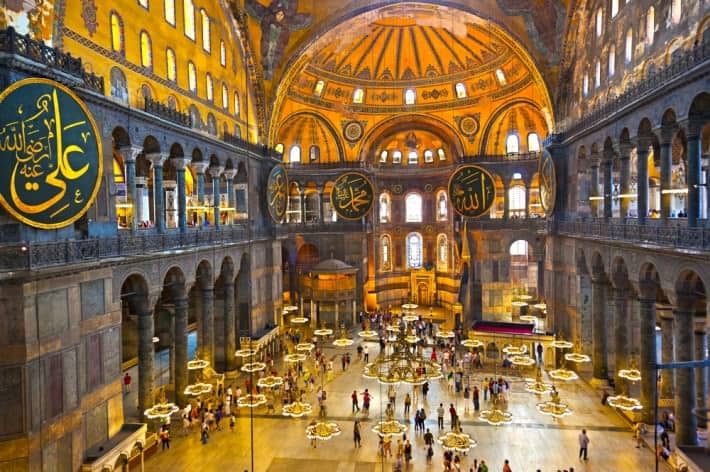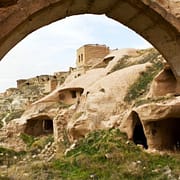Church Of Hagia Sophia In Istanbul – A Byzantine Masterpiece
The Church of Hagia Sophia in Istanbul was built during the 6th century. between 532 and 537 in what was then Constantinople. It was constructed under the orders of Byzantine Emperor Justinian to seve as a Christian Cathedral.
It is nothing short of an architectural masterpiece which continues to attract tourists from around the world to this day. Not surprisingly, the Hagia Sophia is currently included in all of our Egypt and Turkey tours.

Hagia Irene (left) and the Church of Hagia Sophia in Istanbul, Turkey.
7 Intersting facts about the Church of Hagia Sophia in Istanbul
1. Hagia Sophia, originally built as a Byzantine church in Constantinople (modern-day Istanbul) in the 6th century, is one of the greatest surviving examples of Byzantine architecture.
2. Hagia Sophia served as the world’s largest cathedral for nearly a thousand years.
3. The church was converted into a mosque after the Ottoman conquest of Constantinople in 1453 and remained a mosque for almost 500 years before being turned into a museum in 1935.
4. Hagia Sophia is famous for its massive dome, which is considered an architectural marvel and was the largest of its kind until the construction of the Florence Cathedral dome.
5. The church’s interior is adorned with stunning Byzantine mosaics, some of which date back to the 9th century and depict various religious scenes and figures.
6. The current structure of Hagia Sophia has undergone several renovations over the centuries, including the construction of 4 minarets.
7. In July 2020, Turkish President Recep Tayyip Erdoğan issued a decree converting Hagia Sophia Museum back into what is today known as the Hagia Sophia Grand Mosque.
A Brief History
Originally built in 537, the Church of Hagia Sophia in Istanbul was initially a Greek Orthodox basilica church. For nearly 1,000 years, the church was used as an Eastern Orthodox Cathedral. However, when Constantinople got swallowed up the Latin Empire, the church was soon converted into a Roman Catholic cathedral, and it was used as such from 1204 to 1261. Today, Hagia Sophia typically enjoys the top spot on any list of must-see Turkey tourist attractions.
From a 6th Century Byzantine Cathedral to the Grand Mosque of Sultan Mehmet

Hagia Sophia
In 1453 the Ottoman Turks led by Sultan Mehmed II finally managed to topple Constantinople. The new rulers soon gave the orders for the church to be converted into a mosque. Being almost 1,000 years old at the time, this breathtaking Catholic cathedral had fallen into a state of disrepair.
However, it was beautifully restored during the conversion into an imperial mosque, but many of its original Christian relics were removed in order to make way for Islamic specific features, including Islamic calligraphy, the addition four minarets, an ablution fountain and etc..
The original Hagia Sophia Church, with its iconic Hagia Sophia dome, which upon its conversion into the Hagia Sophia Grand Mosque, served as the primary place of worship for Muslims in Istanbul until the 17th century, in 1616. At this point, the big newly built Sultan Ahmed Mosque, also known as the Blue Mosque, became the city’s main mosque.
Travel Tip: If you are going to be visiting the Grand Hagia Sophia Mosque, you might also want to consider visiting the Sultan Ahmed Mosque (Blue Mosque) and the splendid Topkapi Palace. All three of these attractions are within walking distance from each other, and all are among the top attractions in Istanbul.
From Hagia Sophia Mosque to Hagia Sophia Museum
During the 20th century, In 1931, after nearly fourteen centuries of being a place of worship, the complex structure (mosque) shut its doors to devotees. It remained closed to the public for a period of four years, and then in 1935, this engineering marvel with its famous domed roof was officially opened as a museum.
Unfortunately for many, on the 10th of July 2020, Turkey’s top court stripped Hagia Sophia of its museum status, thereby allowing this iconic Byzantine structure to once again be used as a mosque. The decision to do has proved to be very controversial, both in Turkey and around the world.
Church of Hagia Sophia in Istanbul And The Fall Of Constantinople
The battle for Constantinople was a bloody one which eventually ended with the invasion of the Ottoman Turks. In those days it was custom to allow the troops of an invading army to loot and pillage the city they had just invaded for three days, and Constantinople was no exception to the rule.
During the battle leading up to the invasion, many of the city’s inhabitants who were unable to fight, sought refuge in the Church of Hagia Sophia in Istanbul. Unfortunately, when the city fell, the church was one of the first places to be targeted by the invading troops.
Those people who were inside seeking refuge were shown no mercy. The frail and the elderly were simply slaughtered, while most of the women and girls were raped and then chained, along with the boys, and later sold into slavery.
The church itself was severely damaged during the three days of looting and pillaging, and if it weren’t for Sultan Mehmet giving the order to convert Hagia Sophia into a mosque, there probably wouldn’t be any Church of Hagia Sophia in Istanbul today.
More Recent Repairs To Save Hagia Sophia
Repairs and conservation work has taken place several times since its conversion to a mosque. One of the most significant restoration projects took place from 1847 to 1849. During this time a team of around 800 workers were employed for the task. Mosaics were restored, chandeliers fitted, pillars straightened, and etc.
From 1997 to 2002, more major restoration work got under way, this time funded by the World Monuments Fund. The second phase of this restoration project was however only completed in 2006.
Hagia Sophia As It Stands Today

Hagia Sophia Interior
Because of the age and the sheer size of the Church of Hagia Sophia in Istanbul, restoration work always seems to be ongoing, and it always will be if this spectacular Byzantine masterpiece is to be saved for future generations to see.
Some people refer to it as a mosque, while others refer to it as a church, but most will agree that it’s the grandest surviving example of Byzantine architecture. You can secure your trip to the Church of Hagia Sophia in Istanbul right now. Our Egypt and Turkey tours are specifically designed to feature all the very best attractions, but if you don’t see a tour you like, let us know and we’ll tailor one just for you.
9 Must-See Features at Hagia Sophia
The entire Hagia Sophia complex is beyond breathtaking, but below we take a brief look at 8 features which are guaranteed to enthrall all who visit the Church of Hagia Sophia in Istanbul:
1. The Iconic Hagia Sophia Dome
The iconic central dome might look spectacular from the outside, but the interior of the domed roof is even far more spectacular. With a diameter of 31.24 meters, the distance from floor level to the top of the central dome is a staggering 56 meters.
2. The Emperor’s Door
Located on the southern facade of the south gallery, this breathtaking entrance with its intricate designs and marble carvings was reserved purely for emperors. The entrance clearly reflects the exalted status of emperors.
3. The Imperial Lodge
This was located on the second floor of Hagia Sophia and served as a private viewing area for Byzantine emperors during religious ceremonies. From this vantage point, the emperors had a panoramic view of the activities below. The lodge was intricately designed and strategically positioned to showcase the blend of political authority and religious reverence. This allowed the emperors to observe the liturgy while maintaining a sense of regal presence.
4. The Deesis Mosaic
The Deesis Mosaic is located in the southern gallery of Hagia Sophia. It shows Christ at the center, with the Virgin Mary and John the Baptist on each side. The mosaic is known for its intricate details, expressive faces, and vibrant colors, conveying a strong sense of spirituality and artistic excellence. It is a focal point for both religious devotion and appreciation of its artistic beauty.
5. The Wishing Column
The Wishing Column at Hagia Sophia is known for its mystical powers. According to legend, it can grant wishes and heal ailments, attracting many visitors. People insert their thumbs into a small hole in the column and make a wish, believing in its divine power. If their thumb comes out moist, it is thought that their wish will come true.
6. The Mihrab
The Mihrab is an ornate semicircular niche in the apse of Hagia Sophia. It points towards Mecca, indicating the direction of prayer for Muslims. This element was added after Hagia Sophia was converted into a mosque, blending Byzantine and Islamic architectural styles. The intricate decoration of the Mihrab reflects the cultural and religious fusion of the building, symbolizing the meeting point of different civilizations.
7. The Minbar
The Minbar is located next to the Mihrab and is used for delivering Islamic sermons. It is an elevated platform that also serves as a piece of art, displaying the intricate workmanship of Ottoman craftsmen. The ornate carvings and decorative patterns on the Minbar highlight the artistic and religious importance of Hagia Sophia as a mosque, emphasizing its role in the Islamic tradition.
8. Viking Inscription
A Viking inscription in the south gallery of Hagia Sophia says “Halvdan was here,” dating back to the 9th century. It was carved by a Norse mercenary, connecting the monument to the Viking age. This inscription highlights the far-reaching influence of the Byzantine Empire and signifies interactions between different cultures and regions.
9. Devil’s Prison
The Devil’s Prison legend adds intrigue to Hagia Sophia’s history. According to the story, a demon was trapped in marble by Akşemsettin after the Ottoman conquest. This tale reflects the spiritual conflicts and historical changes that occurred in the Church of Hagia Sophia in Istanbul, blending myth, religion, and history within its walls.
Church of Hagia Sophia in Istanbul – Frequently Asked Questions
What is the history behind the Hagia Sophia in Istanbul?
The Church of Hagia Sophia in Istanbul was originally built as a Christian cathedral in the Byzantine Empire during the 6th century. It served as the seat of the Eastern Orthodox Church for nearly a thousand years and then it was converted into a mosque after the Ottoman conquest of Constantinople in 1453. In 1935, it was converted into a museum by the Turkish government.
Is there still Christian artwork and mosaics inside the Hagia Sophia?
Yes, despite its conversion into a mosque, the Hagia Sophia still contains many Christian mosaics and artwork from its time as a cathedral. These artworks are a unique blend of Christian and Islamic symbolism and are a testament to the building’s rich history.
Can I visit the Church of Hagia Sophia in Istanbul now that it a mosque?
Despite the Hagia Sophia being converted into a mosque, it open for tourists of all faiths. At Egypt Tours Plus, we can provide you with a high quality private guided tour of the site. You will also find the Hagia Sophia featured in nearly all of our epic Egypt and Turkey combination tours.
Is the Hagia Sophia still used as a place of worship?
In 2020, the Turkish government decided to convert the Hagia Sophia back into a mosque for Muslim worship but because this decision has sparked controversy and debate both locally and internationally, the building remains open to visitors regardless of their religious beliefs.
Egypt and Turkey Tours
Learn more about our Egypt and Turkey Tours here…
Last Updated on May 6, 2025











